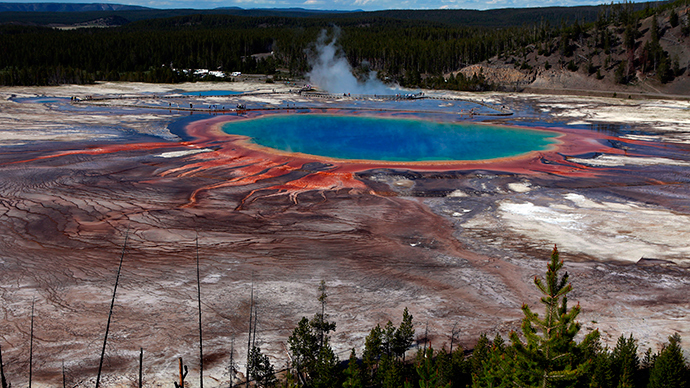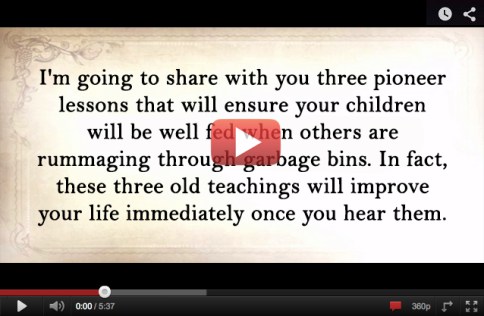The supervolcano at Yellowstone National Park has been hit with more than 400 earthquakes since June 12. Researchers say it’s nothing to be alarmed about, though.In a statement to the Star Valley Independent, scientists from the University of Utah — which monitors the volcano — said the earthquake swarms are nothing new.
“This is the highest number of earthquakes at Yellowstone within a single week in the past five years, but is fewer than weekly counts during similar earthquakes swarms in 2002, 2004, 2008 and 2010,” scientists explained.
In the event of a full-scale eruption of Yellowstone, virtually the entire northwest United States will be completely destroyed. Basically everything within a 100 mile radius would be immediately killed, Salt Lake City would literally be toast, and almost everyone and everything in Denver would be dead in short order.
Further away, volcanic ash would rain down continually for weeks. Those foolish enough to step outside would quickly discover that the ash turns into a substance similar to cement in the lungs, and many would die from suffocation.The amount of volcanic ash released by Yellowstone would be almost unimaginable. In fact, it has been estimated that a full-blown eruption would dump a layer of volcanic ash that is at least 10 feet deep up to 1,000 miles away.
Food production in America would be almost totally wiped out, and the “volcanic winter” that would result from a Yellowstone eruption would dramatically cool the planet. Some have projected that global temperatures would decline by up to 20 degrees.
In the end, the death, famine and destruction that we would experience would be vastly greater than anything that we have ever seen in the history of western civilization.So yes, there is reason to be concerned that weird stuff is going on at Yellowstone right now.
So what should we do?
As always, we should never give in to fear. There are definitely going to be major earthquakes and historic volcanic eruptions in North America, and we are going to have to deal with them. Doing some common sense things in advance will give you and your family the best chance of calmly and smoothly making it through such a crisis.
Below, I have shared some tips that come directly from the CDC. This first set of tips suggests things that you and your family can do to get prepared for a major earthquake…
—–
Gather Emergency Supplies
Stock up now on emergency supplies that can be used after an earthquake. These supplies should include a first aid kit, survival kits for the home, automobile, and workplace, and emergency water and food. Store enough supplies to last at least 3 days.
Evacuation Plans
If an earthquake occurs, you may need to evacuate a damaged area afterward. By planning and practicing for evacuation, you will be better prepared to respond appropriately and efficiently to signs of danger or to directions by civil authorities.
- Take a few minutes with your family to discuss a home evacuation plan. Sketch a floor plan of your home; walk through each room and discuss evacuation details.
- Plan a second way to exit from each room or area, if possible. If you need special equipment, such as a rope ladder, mark where it is located.
- Mark where your emergency food, water, first aid kits, and fire extinguishers are located.
- Mark where the utility switches or valves are located so that they can be turned off, if possible.
- Indicate the location of your family’s emergency outdoor meeting place.
Establish Priorities
Take time before an earthquake strikes to write an emergency priority list, including:
- important items to be hand-carried by you
- other items, in order of importance to you and your family
- items to be removed by car or truck if one is available
- things to do if time permits, such as locking doors and windows, turning off the utilities, etc.
Write Down Important Information
Make a list of important information and put it in a secure location. Include on your list:
- important telephone numbers, such as police, fire, paramedics, and medical centers
- the names, addresses, and telephone numbers of your insurance agents, including policy types and numbers
- the telephone numbers of the electric, gas, and water companies
- the names and telephone numbers of neighbors
- the name and telephone number of your landlord or property manager
- important medical information, such as allergies, regular medications, etc.
- the vehicle identification number, year, model, and license number of your automobile, boat, RV, etc.
- your bank’s or credit union’s telephone number, account types, and numbers
- radio and television broadcast stations to tune to for emergency broadcast information
Gather and Store Important Documents in a Fire-Proof Safe
- Birth certificates
- Ownership certificates (automobiles, boats, etc.)
- Social Security cards
- Insurance policies
- Wills
- Household inventory, including:
- list of contents
- photographs of contents of every room
- photographs of items of high value, such as jewelry, paintings, collectors’ item
—–
Preparing for a volcanic eruption requires a strategy that is a little bit different. Here are more tips from the CDC…
—–
If you are told to evacuate
Follow authorities’ instructions if they tell you to leave the area. Though it may seem safe to stay at home and wait out an eruption, doing so could be very dangerous. Volcanoes spew hot, dangerous gases, ash, lava, and rock that are powerfully destructive.
Preparing to evacuate
- Tune in the radio or television for volcano updates.
- Listen for disaster sirens and warning signals.
- Review your emergency plan and gather your emergency supplies. Be sure to pack at least a 1-week supply of prescription medications.
- Prepare an emergency kit for your vehicle with food, flares, booster cables, maps, tools, a first aid kit, a fire extinguisher, sleeping bags, a flashlight, batteries, etc.
- Fill your vehicle’s gas tank.
- If no vehicle is available, make arrangements with friends or family for transportation, or follow authorities’ instructions on where to obtain transportation.
- Place vehicles under cover, if at all possible.
- Put livestock in an enclosed area. Plan ahead to take pets with you, but be aware that many emergency shelters cannot accept animals.
- Fill your clean water containers.
- Fill sinks and bathtubs with water as an extra supply for washing.
- Adjust the thermostat on refrigerators and freezers to the coolest possible temperature. If the power goes out, food will stay cooler longer.
As you evacuate
- Take only essential items with you, including at least a 1-week supply of prescription medications.
- If you have time, turn off the gas, electricity, and water.
- Disconnect appliances to reduce the likelihood of electrical shock when power is restored.
- Make sure your automobile’s emergency kit is ready.
- Follow designated evacuation routes—others may be blocked—and expect heavy traffic and delays.
If you are told to take shelter where you are
- Keep listening to your radio or television until you are told all is safe or you are told to evacuate. Local authorities may evacuate specific areas at greatest risk in your community.
- Close and lock all windows and outside doors.
- Turn off all heating and air conditioning systems and fans.
- Close the fireplace damper.
- Organize your emergency supplies and make sure household members know where the supplies are.
- Make sure the radio is working.
- Go to an interior room without windows that is above ground level.
- Bring your pets with you, and be sure to bring additional food and water supplies for them.
- It is ideal to have a hard-wired (non-portable) telephone in the room you select. Call your emergency contact—a friend or family member who does not live near the volcano—and have the phone available if you need to report a life-threatening condition. Remember that telephone equipment may be overwhelmed or damaged during an emergency.
—–
In the end, you have got to do what you feel is best for you and your family.
Personally, I would be extremely hesitant to live in very high risk areas along the west coast or near the Yellowstone supervolcano. This is especially true considering how dramatically global seismic activity is increasing.
But others point to the fact that these “danger areas” have not seen any major events in decades, so they wonder what all of the fuss is about.
Would you be able to sustain your loved ones when all hell brakes loose?In this video, I will unearth a long-forgotten secret that helped our ancestors survive famines, wars, economic crises, diseases, droughts, and anything else life threw at them… a secret that will help you do the same for your loved ones when America crumbles into the ground.I’m also going to share with you three old lessons that will ensure your children will be well fed when others are rummaging through garbage bins.Watch the video below to learn all about the 3 skills that will help you thrive in any crises situation:




